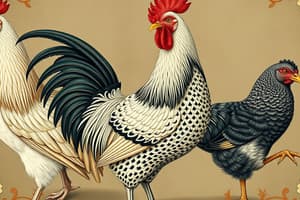Podcast
Questions and Answers
What is the maximum age classification for broilers and fryers in poultry?
What is the maximum age classification for broilers and fryers in poultry?
- 8 weeks old
- 10 weeks old (correct)
- 5 weeks old
- 12 weeks old
What is required for poultry grading to take place?
What is required for poultry grading to take place?
- Mandatory inspection and voluntary grading (correct)
- Grading without any inspection
- Voluntary inspection and mandatory grading
- Inspection and grading both mandatory
Which of the following is NOT a type of poultry?
Which of the following is NOT a type of poultry?
- Frozen
- Raw (correct)
- Dressed
- Cooked
At what internal temperature is poultry considered well done?
At what internal temperature is poultry considered well done?
What does the grading criteria of poultry NOT include?
What does the grading criteria of poultry NOT include?
What preparation safety tip is specifically highlighted for ready-to-cook poultry?
What preparation safety tip is specifically highlighted for ready-to-cook poultry?
Which internal temperature must stuffing in poultry reach for safety?
Which internal temperature must stuffing in poultry reach for safety?
Which poultry classification includes Toms and Hens?
Which poultry classification includes Toms and Hens?
What indicates that poultry is well-done when pressed?
What indicates that poultry is well-done when pressed?
How long can fresh, ready-to-cook poultry be safely stored in the refrigerator?
How long can fresh, ready-to-cook poultry be safely stored in the refrigerator?
What is the recommended temperature for safely storing fresh poultry in the refrigerator?
What is the recommended temperature for safely storing fresh poultry in the refrigerator?
Which type of fish is categorized as an invertebrate?
Which type of fish is categorized as an invertebrate?
What is a distinguishing characteristic of saltwater fish compared to freshwater fish?
What is a distinguishing characteristic of saltwater fish compared to freshwater fish?
What happens to poultry once it is thawed?
What happens to poultry once it is thawed?
Which of the following indicates that a bird is properly cooked?
Which of the following indicates that a bird is properly cooked?
What is the typical storage duration for frozen whole poultry at -18°C?
What is the typical storage duration for frozen whole poultry at -18°C?
What is a sign that fish is aging or has been handled roughly?
What is a sign that fish is aging or has been handled roughly?
Which type of shellfish can be purchased both live and processed?
Which type of shellfish can be purchased both live and processed?
How long can certain types of fish be stored in the freezer?
How long can certain types of fish be stored in the freezer?
What method is recommended for thawing fish?
What method is recommended for thawing fish?
What should be observed during the selection of live mollusks?
What should be observed during the selection of live mollusks?
What condition should fresh shellfish be in when purchased?
What condition should fresh shellfish be in when purchased?
What is not recommended for the storage of fresh fish?
What is not recommended for the storage of fresh fish?
Which observable change indicates decay in a fresh fish?
Which observable change indicates decay in a fresh fish?
Study Notes
Poultry Classification
- Poultry classification depends on age and gender
- Chickens are classified as broilers and fryers, with a maximum age of 10 weeks
- Turkeys are classified as toms and hens
Poultry Composition
- Similar to meat, poultry is comprised of muscle tissue, connective tissue, etc.
- Both white and dark meat are present in chickens and turkeys
Poultry Grading
- Poultry inspection for shipped lines is mandatory
- Poultry grading is voluntary and paid for by the producer
- Three USDA grades are used: A, B, and C
- USDA grade shield is used only for graded poultry
- Grading criteria includes: conformation, fleshing (amount and distribution of fat), and freedom from blemishes
Poultry Types and Styles
- Type: Refers to whether poultry is fresh, frozen, cooked, sliced, canned, or dehydrated
- Style: Describes the degree to which poultry has been cleaned or processed, including live, dressed, ready-to-cook, and convenience categories
Poultry Preparation Safety Tips
- All ready-to-cook poultry should be washed inside and out, then patted dry
- Frozen poultry should be thawed in the refrigerator
Poultry Doneness
- Internal temperature should reach 180° to 185°F (82° to 85°C)
- Stuffing should reach a minimum temperature of 165°F (74°C)
- Poultry doneness can be determined by a thermometer, color change, touch, and time/weight tables
- Well-done poultry will have a golden brown color, clear juices, firm flesh, and a drumstick that does not wiggle.
Poultry Storage
- Fresh poultry can be kept safely in the refrigerator at 40°F (4°C) for up to three days.
- It should be stored in the bottom portion of the refrigerator to prevent contamination of other foods.
- Frozen whole poultry can be stored from six to twelve months at (-18°C).
- Do not re-freeze poultry once it has been thawed.
Fish & Shellfish Types
- Vertebrate: Finfish with fins and internal skeletons
- Invertebrate: Shellfish, including crustaceans and mollusks
- Crustaceans have a segmented body with a hard exoskeleton
- Mollusks have a soft, unsegmented body, with a shell
Fish & Shellfish Classification
- Saltwater fish often have a stronger flavor than freshwater fish
- Fish are generally lean compared to other meats
Fish & Shellfish Purchasing
- Fish processors may submit to voluntary inspection and grading
- Fish can be purchased fresh or frozen, in various forms: whole, drawn, dressed, steaks, fillets, and sticks
Signs of Decay in Fresh Fish
- Flattened, concave eyes
- Gray or creamy brown pupil
- Opaque and discolored cornea
- Paler brown gills
- Gaping, a sign of rough handling
Purchasing Shellfish
- Live shellfish, such as lobsters, crabs, oysters, and clams, can be purchased in their shells
- Shellfish are highly perishable
- Select live mollusks that close more tightly when tapped
- Processed shellfish can also be bought cooked in the shell, chilled, or frozen
- Oysters can be purchased live in the shell, or shucked and chilled, frozen, or canned
Fish & Shellfish Storage
- Fresh fish should be consumed within a day or two of purchase
- Fresh shellfish should be eaten the day they are bought
- Store fish in the coldest part of the refrigerator
- Store crabs in the coldest part of the refrigerator and consume within a day or two
- Frozen fish can be stored for up to nine months
- Fish should be thawed in the refrigerator prior to preparation
Studying That Suits You
Use AI to generate personalized quizzes and flashcards to suit your learning preferences.
Related Documents
Description
Test your knowledge on poultry classification, composition, grading, and various types and styles of poultry. This quiz covers essential criteria used for grading poultry by the USDA and the distinctions between poultry types. Dive into the details of what makes poultry unique in the meat industry!




